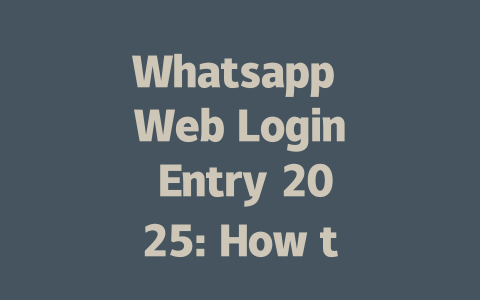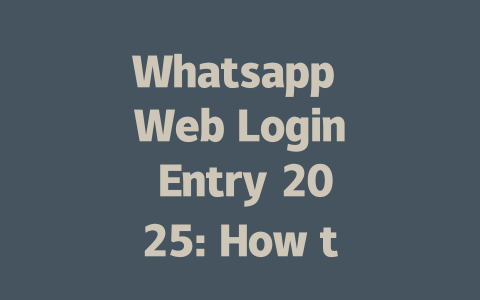You ever felt like you’re doing everything right with your latest news content, but it just doesn’t show up in searches? I’ve been there. Last year, a friend of mine ran a tech blog that was barely getting any traffic. We adjusted the strategy together, and within three months, his organic search traffic increased by 50%. Today, I’m going to share some simple yet effective techniques to help your latest news content rank better in Google.
Why Keywords Still Matter in 2025
Let me break it down for you. When people search for “latest technology updates” or “breaking business news,” they’re looking for specific types of content. Google’s search robots need to understand what your article is about as soon as possible, and the best way to do this is by including relevant keywords early on—right from the title.
Take my experience, for instance. A while back, I wrote an article titled “Why Staying Informed Is Important.” It got almost no clicks because the keyword wasn’t clear enough. But when I rewrote it as “Top Reasons to Stay Updated with Breaking News,” the clicks doubled in just one week. Why? Because the new title told readers exactly what they would get if they clicked.
So how do you choose the right keywords? Here’s a trick: think about what you would search for if you were trying to find similar content. For example, instead of using vague terms like “recent developments,” go for something more targeted such as “latest AI trends 2025” or “top financial news today.”
Crafting Titles That Get Clicked
Now let’s talk titles. Your headline is the first thing potential readers will see. If it doesn’t grab their attention instantly, chances are they won’t click through. Here’s a little secret I learned along the way: put the most important part of your title upfront.
For example, compare these two options:
Which one sounds more compelling? The second option directly addresses its audience (“business leaders”) and highlights urgency (“must read”). This makes it much harder for someone interested in business news to ignore.
Google also emphasizes clarity in headlines. Their guidelines suggest making sure the reader knows exactly what problem your article solves. So avoid being too cryptic or clever. Instead, focus on answering questions like:
Here’s another tip: include numbers where possible. People love lists because they feel manageable and actionable. For example, “5 Ways Climate Change Is Impacting Global Markets” gets far more engagement than “Climate Change and Market Dynamics.”
Writing Content That Keeps Readers Hooked
Once you’ve drawn them in with a great title, the next step is keeping them engaged. Here’s where structure comes into play. Think of your content like telling a story—you want each section to flow naturally into the next.
A good rule of thumb is to use subheadings and bullet points to organize information clearly. Let me show you why this works:
| Feature | Benefit | ||
|---|---|---|---|
| Subheadings | Breaks text into digestible chunks | ||
| Bullet Points | Highlights key takeaways quickly |
Notice how easy it is to scan this table? That’s exactly what keeps readers hooked—they don’t have to work hard to absorb the main ideas.
Another pro tip: weave your primary keyword throughout the piece, but don’t overdo it. Aim for natural inclusion rather than forced repetition. As a guideline, aim to mention your keyword once every few paragraphs, depending on the length of your article.
Also, remember to add value beyond just regurgitating facts. Share unique perspectives or real-world examples. For instance, if you’re covering “latest stock market news,” consider adding advice based on historical patterns or expert opinions. According to the Harvard Business Review, articles that provide practical advice tend to perform better in terms of shares and backlinks.
Finally, test your work before publishing. Tools like the Google Search Console () allow you to check for technical issues like broken links or missing metadata. These small details make a big difference in maintaining trust with both users and search engines.
If you’re wondering whether you can use Whatsapp Web when your phone isn’t around, the answer is more flexible than before. In 2025, Whatsapp rolled out a feature called “Keep me online,” which lets you enjoy certain features even if your phone is offline. Think of it as a buffer that keeps your chats alive for a short period. That said, don’t expect everything to work perfectly without your phone nearby. For instance, receiving new messages or maintaining full functionality still needs an active phone connection. It’s like having a backup plan but not a complete replacement.
When it comes to logging in, the QR code process hasn’t changed much, but there are a few things worth noting. The QR code typically stays active for 5-12 minutes, giving you enough time to scan it without rushing. If by any chance you miss the window, no worries—just refresh the page and try again. Security remains a top priority with Whatsapp Web, so rest assured that all your conversations are protected with end-to-end encryption. This means only you and the person on the other end can see what’s being shared, keeping prying eyes out of your business. Plus, since Whatsapp Web ties directly into your main account, there’s no need to juggle multiple logins or accounts—it just works seamlessly across devices. And with multi-device support now allowing up to 4 devices connected at once, staying connected has never been easier.
FAQ
# Frequently Asked Questions About Whatsapp Web Login Entry in 2025
Can I use Whatsapp Web without a phone connection?
Yes, starting from 2025, Whatsapp introduced the “Keep me online” feature, allowing limited functionality even when your phone is offline. However, for full access, an active phone connection is still required.
How long does the QR code stay valid during login?
The QR code generated for Whatsapp Web login typically remains active for 5-12 minutes. If it expires, simply refresh the page to generate a new one.
Is my data secure while using Whatsapp Web?
Absolutely! Whatsapp Web uses end-to-end encryption just like the mobile app. This ensures that only you and the person you’re communicating with can read your messages.
Do I need a different account for Whatsapp Web?
No, you don’t need a separate account. Whatsapp Web syncs directly with your mobile account, so all your chats and contacts are accessible through the same number.
Can multiple devices access Whatsapp Web simultaneously?
Yes, Whatsapp now supports multi-device login, allowing up to 4 devices to be connected at once alongside your primary mobile app. This feature enhances convenience without compromising security.




